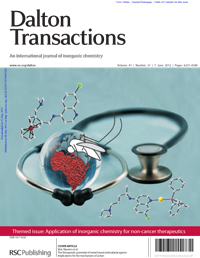 |
This month we are highlighting some of the excellent articles published in Dalton Transactions from South Korea.
Click on the links below to download the articles… |
A double-walled triangular metal-organic macrocycle based on a [Cu2(COO)4] square paddle-wheel secondary building unit
Xiaokai Song, Xinfang Liu, Minhak Oh and Myoung Soo Lah
Dalton. Trans., 2010, 39, 6178–6180
Preparation and characterisation of divalent hard and soft metal (M = Ca, Co, Cu, Zn, Cd, Hg and Pb) complexes of 1,10-dithia-18-crown-6: structural versatility
In-Hyeok Park, Ki-Min Park and Shim Sung Lee
Dalton Trans., 2010, 39, 9696–9704
Self-assembled molecular squares containing metal-based donor: synthesis and application in the sensing of nitro-aromatics
Vaishali Vajpayee, Hyunuk Kim, Anurag Mishra, Partha Sarathi Mukherjee, Peter J. Stang, Min Hyung Lee, Hwan Kyu Kim and Ki-Whan Chi
Dalton Trans., 2011,40, 3112–3115
| Two-dimensional metal–organic frameworks with blue luminescence Seong Huh, Suhyun Jung, Youngmee Kim, Sung-Jin Kim and Seongsoon Park Dalton Trans., 2010, 39, 1261–1265 |
 |
Canted antiferromagnetism and spin reorientation transition in layered inorganic–organic perovskite (C6H5CH2CH2NH3)2MnCl4
Seong-Hun Park, In-Hwan Oh, Sungil Park, Younbong Park, Ji Hyun Kim and Young-Duk Huh
Dalton Trans., 2012, 41, 1237–1242
Self-assembled metalla-bowls for selective sensing of multi-carboxylate anions
Anurag Mishra, Vaishali Vajpayee, Hyunuk Kim, Min Hyung Lee, Hyunji Jung, Ming Wang, Peter J. Stang and Ki-Whan Chi
Dalton Trans., 2012, 41, 1195–1201
Anion variation on a cobalt(III) complex of salen-type ligand tethered by four quaternary ammonium salts for CO2/epoxide copolymerization
Jina Yoo, Sung Jae Na, Hyeong Cheol Park, Anish Cyriac and Bun Yeoul Lee
Dalton Trans., 2010, 39, 2622–2630
 |
Why not check out last year’s New Talent: Asia themed issue for more articles from Korea and beyond? |
















 Guest Editor: Professor Bob Crabtree, Yale University
Guest Editor: Professor Bob Crabtree, Yale University


